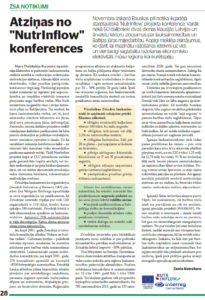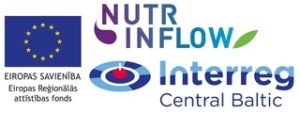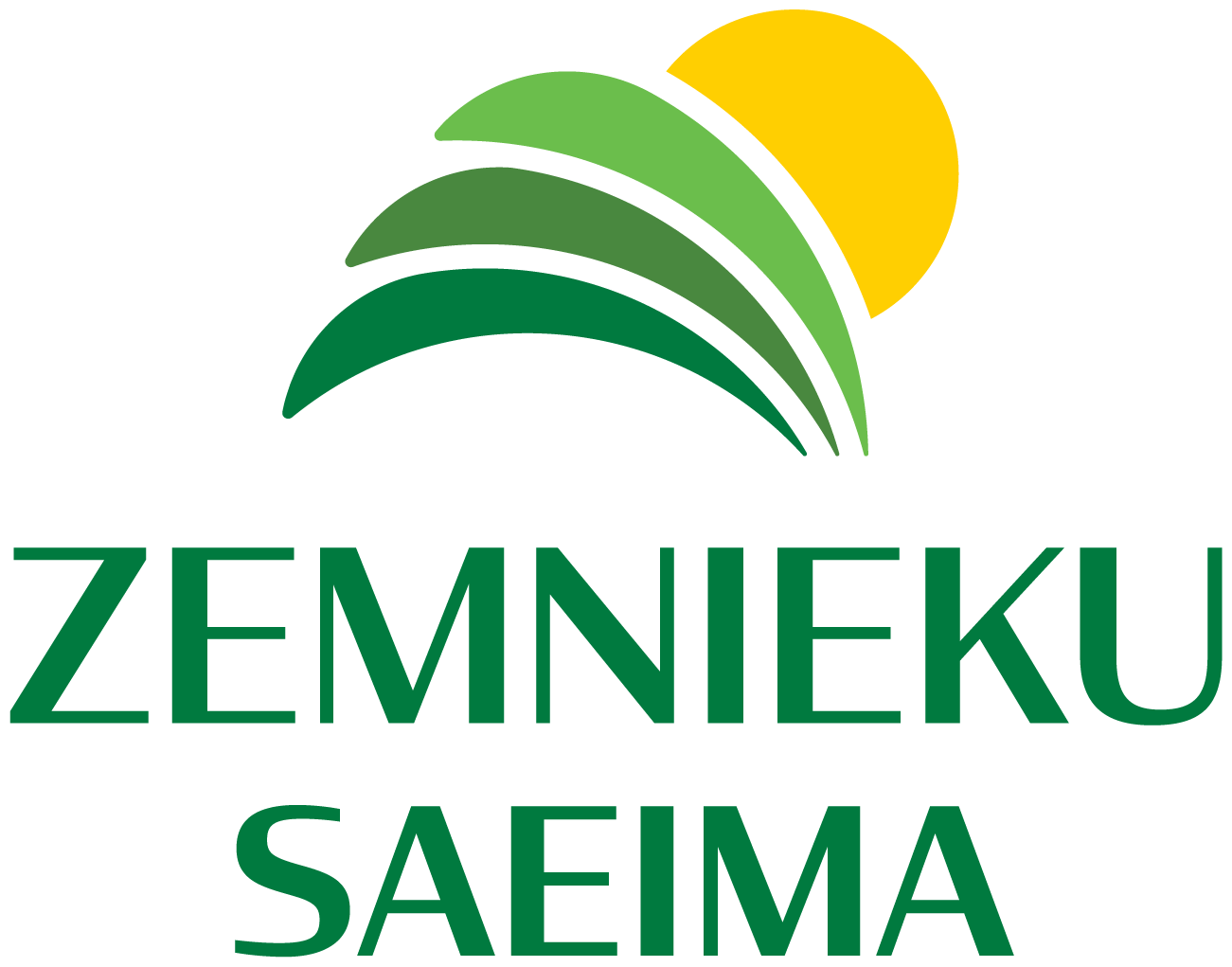NutrInFlow project seminar “Management of reclamation systems”
Environmentally friendly and farmer-friendly land reclamation system solutions are one of the main cornerstones in reducing eutrophication in the Baltic Sea - this is what more than 60 participants, mainly scientists and farmers from Latvia, Estonia, Finland and Sweden, concluded after a conference held in Bauska on November 23-24, 2016.
"Diffuse pollution from agricultural lands throughout the Baltic Sea region is one of the most significant causes of marine eutrophication. It is precisely the influx of nitrogen and phosphorus compounds into the sea that has contributed to its 'dying' in recent decades," says Ari Kultanen, project manager for the Finnish agricultural organization ProAgria.
He also emphasizes that this situation requires a modern and understandable approach - reclamation structures must be efficient in both nutrient retention and field drainage, but they cannot take up a disproportionate amount of space on agricultural lands. "The project "NutrInflow", jointly implemented by Latvia, Finland and Sweden, focuses on developing principles and establishing pilot areas - our goal is to create internationally recognized and modern reclamation systems that will significantly prevent the flow of nitrogen and phosphorus compounds into the sea," points out A. Kultanen, emphasizing that the quality of the Baltic Sea environment begins already in our homes and fields.
As Ainis Lagzdiņš, a professor at the Latvian University of Agriculture, has concluded in his water quality studies, complex solutions provide the greatest effect, however, even they are not always able to fully retain nutrients washed out of the field after heavy rains: “The data obtained at the Vecauce monitoring station shows that a day or two after a significant amount of precipitation, the water flow increases and, consequently, the concentration of phosphorus and nitrogen.” A. Lagzdiņš emphasizes that the Cabinet of Ministers' regulations describe various types of structures - sedimentation basins, two-stage ditches, rock piles, meandering, controlled drainage and artificial wetlands -, however, to achieve a better result, these elements must be combined.
This approach has been implemented by Mārtiņš Cēsnieks, who presented the developed land reclamation systems of the Z/S “Vilciņi”. “A sedimentation basin, a rock fill, a shallow water section with reeds and meandering are used in the ditch, which has a total length of 3.2 kilometers.” According to calculations, the construction of such a system retains up to 95% of suspended particles and purifies 30-40% of nitrogen and phosphorus from runoff, while simultaneously improving the living conditions of many plant and animal species. “In turn, the greatest benefit for farmers is reduced flood impact, optimal moisture in the fields and improved environmental quality,” concludes M.Cēsnieks.
In Latvia, the Lielupe catchment area has been selected as the project area. Five potential sites for the system construction have already been selected for demonstrations in the Aile stream. “The reality for farmers today is that the drainage systems are worn out, the climate is becoming increasingly extreme – precipitation exceeds evaporation by 250mm – and environmental requirements are becoming stricter,” explains Maira Dzelzkalēja-Burmistre, a representative of the “Farmers’ Council”. She concluded that there is still a lack of knowledge and understanding of the connection between human actions and the sea, however, the activities so far in the “NutrInflow” pilot areas are promising, and mutually beneficial solutions have been found.
Similarly, in Latvia, the Sodīte stream in Jelgava region has been selected as a pilot area. An inventory and study of the drainage systems have already been carried out here, and the most appropriate construction project is being developed so that construction work can begin in 2017. According to Ingars Rozītis, the reclamation inspector of the Jelgava region municipality, in order to promote awareness of the role of each individual in the cleanliness of the sea, educational activities are being implemented with students of the Aizupe primary school in Jelgava region. “Organisms that are involved in water purification also live in the ditch. Aizupe primary school is one of the most active schools in the region, and its students, thanks to this project, have become “Sodīte ambassadors” and have begun to get to know and explore biodiversity in the surrounding environment,” says I. Rozītis.
The conference is organized as part of the activities of the Central Baltic INTERREG IVA program project “NutrInflow”. Similar conferences will be held in Sweden and Finland in 2017 and 2018. “For us – the Nordic countries – the Baltic Sea is like a unifying element, and it is increasingly suffering from eutrophication. We need to preserve the values that have been given to us, passing on a clean and unpolluted sea to future generations. Together we have a clear vision – the activities of the project “NutrInflow” are already making a contribution, and in the future they will further contribute to the recovery of the Baltic Sea and will be a stepping stone for more successful environmental protection!” concludes Sigita Šilvjane, project manager in the Zemgale Planning Region, at the end of the conference.
Article in the ZSA magazine –
All materials from the conference held at Bauska Castle can be found on the project website: nutrinflow.eu/downloads
Information on the Jelgava region website
Information on the Bauska region website
Information on the LLU website
Information on the Diena.lv website
Three countries – Latvia, Finland and Sweden – are collaborating in the “NutrInflow” project, and in addition, leading specialists from not only the Zemgale Planning Region, but also the “Zemnieku Saeima” association, the Latvian Agricultural University and the Jelgava regional municipality have been involved in the development of the pilot territory – the Lielupe catchment area – in Latvia.
Agenda
He also emphasizes that this situation requires a modern and understandable approach - reclamation structures must be efficient in both nutrient retention and field drainage, but they cannot take up a disproportionate amount of space on agricultural lands. "The project "NutrInflow", jointly implemented by Latvia, Finland and Sweden, focuses on developing principles and establishing pilot areas - our goal is to create internationally recognized and modern reclamation systems that will significantly prevent the flow of nitrogen and phosphorus compounds into the sea," points out A. Kultanen, emphasizing that the quality of the Baltic Sea environment begins already in our homes and fields.
As Ainis Lagzdiņš, a professor at the Latvian University of Agriculture, has concluded in his water quality studies, complex solutions provide the greatest effect, however, even they are not always able to fully retain nutrients washed out of the field after heavy rains: “The data obtained at the Vecauce monitoring station shows that a day or two after a significant amount of precipitation, the water flow increases and, consequently, the concentration of phosphorus and nitrogen.” A. Lagzdiņš emphasizes that the Cabinet of Ministers' regulations describe various types of structures - sedimentation basins, two-stage ditches, rock piles, meandering, controlled drainage and artificial wetlands -, however, to achieve a better result, these elements must be combined.
This approach has been implemented by Mārtiņš Cēsnieks, who presented the developed land reclamation systems of the Z/S “Vilciņi”. “A sedimentation basin, a rock fill, a shallow water section with reeds and meandering are used in the ditch, which has a total length of 3.2 kilometers.” According to calculations, the construction of such a system retains up to 95% of suspended particles and purifies 30-40% of nitrogen and phosphorus from runoff, while simultaneously improving the living conditions of many plant and animal species. “In turn, the greatest benefit for farmers is reduced flood impact, optimal moisture in the fields and improved environmental quality,” concludes M.Cēsnieks.
In Latvia, the Lielupe catchment area has been selected as the project area. Five potential sites for the system construction have already been selected for demonstrations in the Aile stream. “The reality for farmers today is that the drainage systems are worn out, the climate is becoming increasingly extreme – precipitation exceeds evaporation by 250mm – and environmental requirements are becoming stricter,” explains Maira Dzelzkalēja-Burmistre, a representative of the “Farmers’ Council”. She concluded that there is still a lack of knowledge and understanding of the connection between human actions and the sea, however, the activities so far in the “NutrInflow” pilot areas are promising, and mutually beneficial solutions have been found.
Similarly, in Latvia, the Sodīte stream in Jelgava region has been selected as a pilot area. An inventory and study of the drainage systems have already been carried out here, and the most appropriate construction project is being developed so that construction work can begin in 2017. According to Ingars Rozītis, the reclamation inspector of the Jelgava region municipality, in order to promote awareness of the role of each individual in the cleanliness of the sea, educational activities are being implemented with students of the Aizupe primary school in Jelgava region. “Organisms that are involved in water purification also live in the ditch. Aizupe primary school is one of the most active schools in the region, and its students, thanks to this project, have become “Sodīte ambassadors” and have begun to get to know and explore biodiversity in the surrounding environment,” says I. Rozītis.
The conference is organized as part of the activities of the Central Baltic INTERREG IVA program project “NutrInflow”. Similar conferences will be held in Sweden and Finland in 2017 and 2018. “For us – the Nordic countries – the Baltic Sea is like a unifying element, and it is increasingly suffering from eutrophication. We need to preserve the values that have been given to us, passing on a clean and unpolluted sea to future generations. Together we have a clear vision – the activities of the project “NutrInflow” are already making a contribution, and in the future they will further contribute to the recovery of the Baltic Sea and will be a stepping stone for more successful environmental protection!” concludes Sigita Šilvjane, project manager in the Zemgale Planning Region, at the end of the conference.
Article in the ZSA magazine –

All materials from the conference held at Bauska Castle can be found on the project website: nutrinflow.eu/downloads
Information on the Jelgava region website
Information on the Bauska region website
Information on the LLU website
Information on the Diena.lv website
Three countries – Latvia, Finland and Sweden – are collaborating in the “NutrInflow” project, and in addition, leading specialists from not only the Zemgale Planning Region, but also the “Zemnieku Saeima” association, the Latvian Agricultural University and the Jelgava regional municipality have been involved in the development of the pilot territory – the Lielupe catchment area – in Latvia.
Agenda
The project “Practical measures in the integrated management of land reclamation systems with the aim of reducing the inflow of nutrients into the Baltic Sea” or “NutrInflow” is being implemented from September 2015 to February 2019 within the Central Baltic Sea Region Programme 2014-2020. The lead partner of the project is the rural business support organisation “ProAgria Southern Finland”, and its total budget is 1.78 million EUR, of which 85% is co-financed by the Central Baltic Sea Region Programme.


